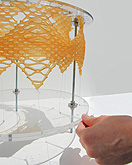News
‘Architecture in motion’ in UB gallery

Reflexive Architecture Machines: (from left to right) “Warped” by Matthew Hume, “Gravity Screen” by Omar Khan, “Allotropic Systems” by Nick Bruscia and “Open Columns” by Omar Khan.
“Reflexive Architecture Machines,” an exhibition featuring architectural prototypes that explore how conventional materials can become more responsive to environmental and human interactions, will be on view Feb. 11 through March 20 in the Second Floor Gallery in the UB Art Gallery in the Center for the Arts, North Campus.
The exhibition will open with a public reception beginning at 5 p.m. Feb. 11.
It presents faculty and student research in responsive materials conducted in the Center for Architecture and Situated Technologies in the School of Architecture and Planning. It displays the products of the design lab through drawings, models, tools, material studies and working prototypes that demonstrate the process by which projects are conceived, researched and developed. “Reflexive Architecture Machines” envisions architecture that is self-organizing, capable of transforming itself in response to changes in its environment or use. It re-imagines how we shape and assemble conventional materials, such as rubber, plastic and wood, through a combination of material and computational processes to develop more complex relations between parts and wholes. This fundamentally challenges the static nature of conventional building materials and sensitizes them to the ephemeral and dynamic qualities of environmental conditions, like heat, moisture, air chemistry and gravity.
Among the projects on view:
• “Allotropic Systems,” designed by Nicholas Bruscia, adjunct assistant professor of architecture, which uses flexible rubber molds to produce self-similar plastic casts. By reusing the same mold to produce one plastic sibling after another, the mutability of both plastic and rubber is exploited to yield considerable formal variety.
• Architecture student Matthew T. Hume’s “Warped,” which offers experiments in plywood construction featuring a set of walls and arches composed from mechanically joined wood plys that change their shape in response to atmospheric moisture by twisting and bending between open and closed conditions.
• “Gravity Screens” and “Open Columns,” by Omar Khan, associate professor of architecture, which explore the possibilities offered by elastomers for developing an organically kinetic architecture. They use the unique quality of this material to build collapsible and expandable structures that move like plants and respond to information gathered by electronic sensors.
As part of the exhibition, “Open Columns” has been installed off site in the Buffalo Arts Studio, Suite 500 in the Tri-Main Center, 2495 Main St., Buffalo, beginning Tuesday and running through Feb. 22. “Open Columns” offers a responsive environment composed of nonstructural columns made from flexible composite urethane elastomers that descend and ascend based on the carbon dioxide (CO2) levels in the given space. The project responds to crowds of people that alter the CO2 chemistry of the air.
Both live and prerecorded video feed will be transmitted to the UB Art Gallery from the Buffalo Arts Studio.
The Buffalo Arts Studio hours are 11 a.m. to 5 p.m. Tuesday through Friday, and from 11 a.m. to 3 p.m. on Saturday. For more information, call 833-4450.
The UB Art Gallery is open from 11 a.m. to 5 p.m. Tuesday through Saturday. For information, call 645-6913.


Reader Comments